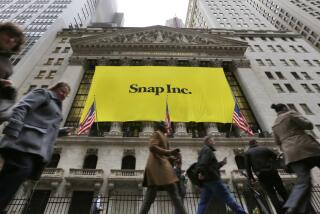All Roads Lead to New-Media Capital
- Share via
To evoke a catty chorus of multimedia meows, just ask the East Coast intelligentsia or West Coast pop culture artistes to predict where tomorrow’s new-media capital will be.
In between bites of kappa maki and deal making, Angelenos will insist that their fingers are firmly pressed on the jugular of pop culture and that all multimedia superhighways inevitably lead to Hollywood. The New Yorkers argue that information is the key and that the multimedia future looks just like publishing. Really. In San Francisco, folks just point south of Market Street to the Neo-Bohemians in Multimedia Gulch. And up in Seattle, the latte crowd gently put down their cups and smugly whisper their multimedia mantra: Bill . . . Bill . . . Bill.
A few seconds later in the conversation, of course, New York will be contemptuously dismissed as a technological tar pit where paper-based publishers honestly think that CD-ROMs represent the state of the multimedia art. San Francisco’s South of Market crowd will be dissed as a gaggle of really bright techno-geeks who don’t understand the first or second thing about business, while the techno-geeks will tell you that Hollywood dresses real pretty for folks who think that C++ is their teen-ager’s grade point average.
As for the Pacific Northwest’s Evil Empire, people take turns fearing Microsoft’s Bill Gates as the John D. Rockefeller of the Information Age or despising him as Software’s Jabba the Hut.
These regional rivalries are taken very seriously. When a leading CD-ROM publisher like Voyager moves from Santa Monica to Manhattan or when AT&T;’s multimedia maven, Bob Kavner, leaves Ma Bell’s bosom for the I.M. Pei-ified glitter of Michael Ovitz’s Creative Artists Agency, people get nervous. Everyone wants to be in the Athens, Rome or Florence of multimedia. Everyone wants to be at The Center.
What’s so ironic about these media rivalries, however, is that the pop culturecrats who proclaim their region as the place to be are precisely the same people who talk about how multimedia networking is making location irrelevant. By rights, a geography-independent medium like the Internet--rather than mere physical co-location--should have greater influence on media creativity and collaboration. If you believe what these moguls are saying, tomorrow’s Multimedia Capital should be more virtual than physical. An Internet--not Hollywood or Manhattan or Redmond--should be the white-hot center of multimedia innovation.
That’s one reason why so many pundits predict the convergence of regional media sensibilities as the technologies themselves converge. The center will be where sensibility and technology profitably converge. (A few wags have thus dubbed the promised convergence of Silicon Valley and Hollywood as “Silliwood.”) The end result will be a vast multimedia Ubernetwork with an MIT Media Lab node here, a Microsoft hub there, all lashed together by fibers and frequencies courtesy of AT&T;, TCI and PacTel.
But, as if in reactionary response to the potential of virtual tele-convergence, regionalism seems more important than ever. When it comes to making new media, virtuality isn’t evolving yet into an adequate substitute for physical presence. Academic surveys of regional economies by Harvard’s Michael Porter and Berkeley’s AnnaLee Saxenian stressing the importance of local networking and informal information exchange seem more relevant than obsolete. Regional rivalries will be on the rise.
Of course, the idea that a Hollywood or New York is well positioned to capture new-media markets because of their entertainment and information assets is as simplistic as believing the Pacific Northwest could dominate the printing industry because it’s close to all those trees, or that Minneapolis will become the creative capital of book publishing because B. Dalton is based there. Regional economic diversification is as much the result of alchemy as strategic planning.
For example, one of the hottest and most popular network products to emerge in recent years is Mosaic, an immensely powerful tool for navigating and participating in the Internet. Mosaic doesn’t come from either coast--it comes from the University of Illinois. If you think about it, that actually makes sense, because there’s absolutely nothing to do in Champaign.
One could make an excellent case that tomorrow’s most interesting network navigation tools won’t come from the dense hotbeds of Silicon Valley or MIT but from regional outposts that have a greater need and urgency to reach out and tap a network’s potential. Remember, cable television began where the Big Three networks couldn’t reach. It’s necessity--not abundance--that is the mother of invention.
The point is, when it comes to regional rivalries, strengths can be weaknesses and weaknesses can be strengths. Microsoft’s great strength--the popularity of its Windows interface--may ultimately prove to be a huge weakness as it’s ported to the consumer marketplace. Conversely, New York publishing’s abysmal technological illiteracy may ultimately prove advantageous because, if an editor can understand the new-media product, then anyone can.
Which begs the question: Are these new media really about the technologies of information and entertainment? Or are they really about creating new forms of interaction and involvement? That’s what these regional rivalries have this decade to determine. Where you are still matters as much as what you think.
More to Read
The biggest entertainment stories
Get our big stories about Hollywood, film, television, music, arts, culture and more right in your inbox as soon as they publish.
You may occasionally receive promotional content from the Los Angeles Times.










